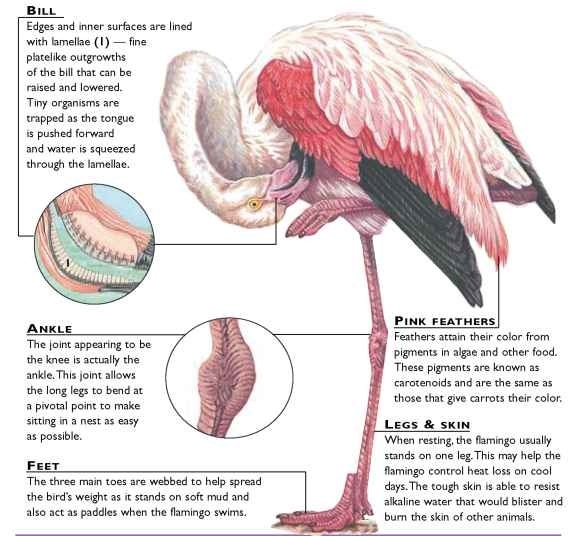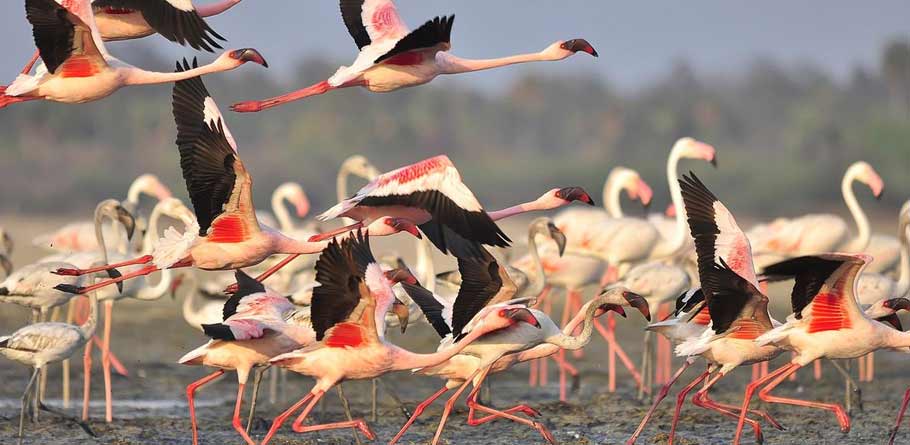Overview
Flamingos, belonging to the family Phoenicopteridae, are among the most recognizable birds due to their tall legs, S-shaped neck, and brilliant pink to reddish-pink plumage. These wading birds, native to both the Western and Eastern Hemispheres, often congregate in massive colonies in shallow alkaline and saline lakes.
Physical Characteristics

Plumage and Coloring
One of the most distinctive aspects of flamingos is their striking pink hue. This comes from their diet consisting predominantly of blue-green algae and invertebrates, which contain carotenoid pigments. When digested, these pigments break down into pink and reddish pigments that deposit into the bird’s feathers, skin, and beak.
Body Structure
Flamingos exhibit a unique build:
- Tall Legs: Their lengthy legs, equipped with webbed feet, are perfectly suited for wading in deep waters.
- S-Shaped Neck: This elongated, flexible neck aids in underwater feeding.
- Bill Design: The downward-curving bill functions as a filter, sifting small food items from the water.
Habitat and Distribution
Natural Habitats
Flamingos predominantly reside in shallow lakes, lagoons, and swampy areas where their specific food sources flourish. The alkalinity or salinity of these waters often keeps potential predators at bay, ensuring safer feeding grounds.
Global Distribution
While Africa hosts the largest number of flamingo species, these birds also stretch across parts of Europe, Asia, the Americas, and the Caribbean. They can thrive in a variety of climates, from the tropical regions of the Caribbean to the cold, high-altitude lakes of the Andes.
Diet and Feeding Habits
Flamingos have a specialized feeding technique. They stir up the mud with their feet, then dip their bill into the water, upside-down. Using their tongue, they pump water through their bill, where small hair-like structures called lamellae trap food particles.
Their diet mainly includes:
- Blue-green algae: Found abundantly in saline lakes.
- Brine shrimp: Contribute significantly to their pinkish hue.
- Aquatic insects: Provide necessary protein.
- Small fish: Consumed occasionally.
Conservation Status and Threats
Though flamingos are widespread, certain species, like the Andean flamingo, are considered vulnerable. Threats to their survival include:
- Habitat loss: Due to draining of wetlands for agriculture.
- Pollution: Affects the quality of water and their food sources.
- Climate change: Alters their habitats and disrupts migration patterns.
Conservation efforts are in place, aiming to secure the flamingo’s habitats and safeguard their numbers.
10 Facts About Flamingos
- Coloration Source: The pink to reddish-pink hue of flamingos is due to their diet, which is rich in carotenoid pigments. As they digest food like blue-green algae and invertebrates, these pigments break down and are deposited into their feathers, skin, and beak.
- Diverse Diet: Besides the commonly known brine shrimp and blue-green algae, flamingos also consume aquatic insects, mollusks, and even small fish.
- Unique Bill: A flamingo’s bill is not just curved but also acts as an effective filter. Small hair-like structures called lamellae inside the bill help trap tiny food particles from the water.
- Wading Experts: The long legs of flamingos aren’t just for show. They are specially adapted for wading in deep waters, allowing the birds to access food sources that other birds might not reach.
- Wide Distribution: Flamingos are not limited to warm, tropical areas. They inhabit a range of environments from the warm Caribbean to the cold, high-altitude lakes of the Andes.
- Huge Colonies: Flamingos are known to gather in colonies that can number in the thousands. These large groups help deter predators and are a fantastic spectacle when they all take flight.
- Upside-Down Feeding: One of the most unique feeding habits of the flamingo is the way they dip their bill upside-down in the water, using their tongue to pump and filter out food.
- Special Feet: Besides their long legs, flamingos have webbed feet. This adaptation helps them stand on soft mud and also aids in swimming.
- Vocal Birds: Flamingos are quite vocal and communicate using honking sounds similar to geese. These vocalizations help keep the flock together, especially during migrations.
- Threatened Species: While several flamingo species have stable populations, some like the Andean flamingo are vulnerable due to habitat loss, pollution, and the effects of climate change.
Conclusion
Flamingos, with their iconic pink hue and distinctive features, are not just a visual spectacle but also vital indicators of the health of their habitats. Their presence signifies the ecological balance of wetlands. Efforts to protect and conserve them go beyond preserving a species; they aim to maintain the harmony and health of entire ecosystems.
Frequently Asked Questions About Flamingos
- Why are flamingos pink?
Flamingos get their pink to reddish-pink hue from carotenoid pigments found in their diet, primarily from blue-green algae and invertebrates. As they digest, these pigments break down and are deposited into their feathers, skin, and beak. - Do flamingos only eat brine shrimp?
No, while brine shrimp are a significant part of their diet, flamingos also consume blue-green algae, aquatic insects, mollusks, and occasionally small fish. - How do flamingos feed in the water?
Flamingos use their uniquely curved bill to filter food from the water. They dip their bill upside-down, pumping water through it using their tongue. Tiny hair-like structures, called lamellae, inside the bill trap food particles. - Where can flamingos be found in the wild?
Flamingos are distributed widely across the world. They inhabit a range of environments from warm areas like the Caribbean to cold high-altitude lakes in the Andes. Africa hosts the largest number of species. - Why do flamingos gather in large colonies?
Flamingos congregate in huge colonies, sometimes numbering in the thousands, to deter predators. The large numbers provide safety, and such gatherings also help in successful breeding. - Do flamingos have webbed feet like ducks?
Yes, flamingos have webbed feet, an adaptation that aids them in standing on soft mud and swimming in water. - How do flamingos communicate with each other?
Flamingos are vocal birds and communicate using honking sounds, similar to geese. These vocalizations play a crucial role in keeping the flock together, especially during migrations. - Are all flamingo species thriving in the wild?
While many flamingo species have stable populations, some, like the Andean flamingo, are considered vulnerable. Threats include habitat loss, pollution, and the adverse effects of climate change. - Do flamingos sleep standing on one leg?
Yes, flamingos often rest or sleep standing on one leg. This posture helps in conserving body heat, as one leg tucked beneath the body loses less heat than if both were exposed to the air. - How long do flamingos live?
In the wild, flamingos can live up to 20-30 years. However, in captivity, with proper care, they can live up to 50 years or more. - Why are baby flamingos grey?
Baby flamingos are born grey and acquire their pink hue as they feed on carotenoid-rich foods. - How many species of flamingos are there?
There are six recognized species of flamingos. - Do flamingos fly?
Yes, flamingos can fly and often migrate to find suitable habitats or food sources. - Why do flamingos stand on one leg?
Flamingos stand on one leg to conserve body heat and energy. - Are flamingos endangered?
Not all species of flamingos are endangered, but some face threats due to habitat loss and pollution.

